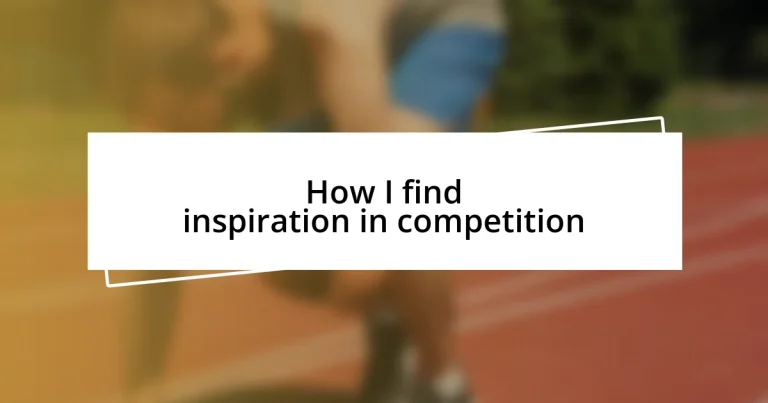Key takeaways:
- Competition can drive personal growth, creativity, and collaboration, transforming challenges into opportunities for improvement.
- Identifying competitive environments involves recognizing clear goals, active participants, performance measurement, resource sharing, and motivational factors.
- Setting competitive goals, maintaining a flexible approach, and learning from competitors’ successes are essential strategies for unlocking personal potential and fostering creativity.
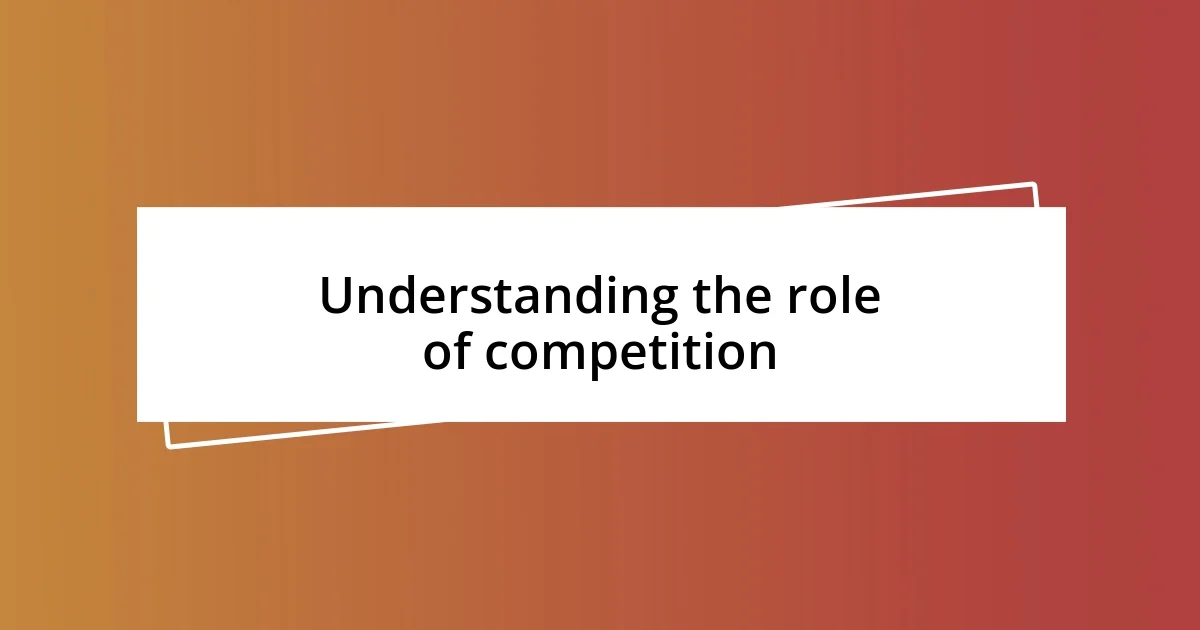
Understanding the role of competition
Competition plays a significant role in driving us to exceed our limits. I remember a time when I was part of a local art competition. It was daunting, but with every brushstroke, I felt pushed to create something truly unique. That urgency sparked creativity I didn’t know I had.
When I think about competition, I often wonder: What if we viewed it not as a threat, but as our greatest motivator? In my experience, competition cultivates an environment of growth and improvement. It encourages us to assess our strengths and weaknesses honestly, providing a framework for personal development.
Reflecting on competitive experiences, I realize they can forge connections among individuals who might otherwise remain strangers. For instance, I found camaraderie with fellow competitors who shared tips and tricks, transforming a potentially isolating experience into one of collaboration. Isn’t it fascinating how competition can bring out the best in us, both individually and collectively?
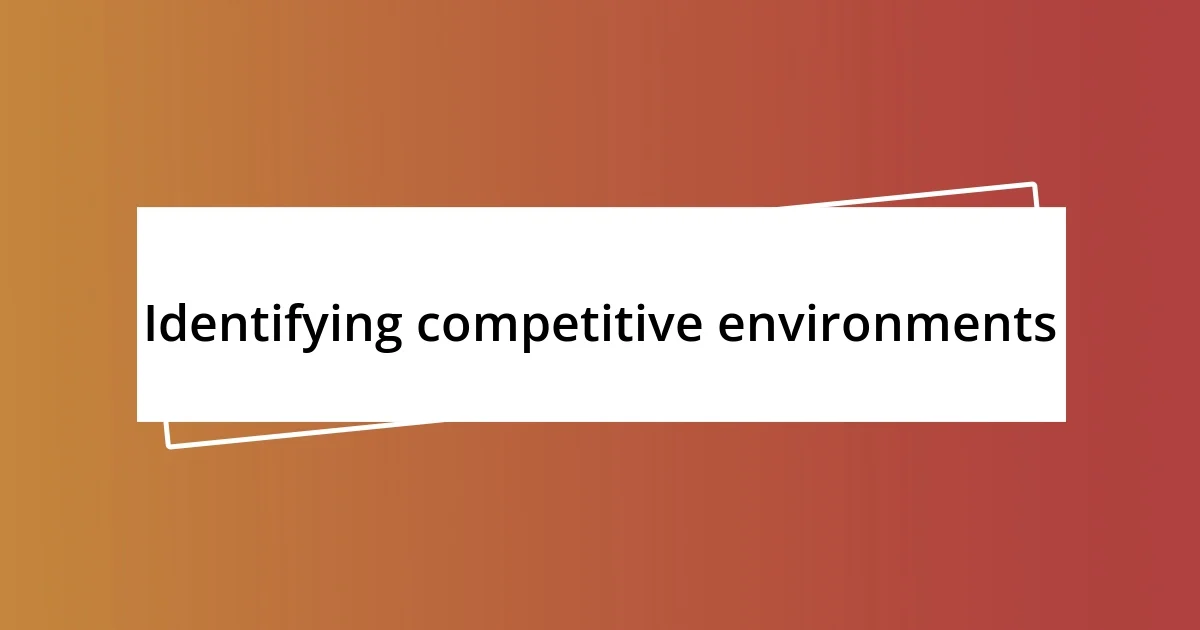
Identifying competitive environments
To identify competitive environments, I first look for areas where individuals or groups are vying for the same goals or resources. For me, it often comes down to observing the dynamics at play in various settings, whether that be at work, in sports, or even in niche hobbies. I remember walking into a local chess tournament where the intensity was palpable; you could feel the electricity in the air as players strategized amidst palpable rivalry.
Here’s a quick guide on what to consider when identifying a competitive environment:
- Clear Goals: Look for scenarios with well-defined objectives that everyone is striving to achieve.
- Active Participants: Identify individuals or teams who are actively engaged and competing against each other.
- Performance Measurement: Recognize environments that evaluate success—like leaderboards, awards, or rankings.
- Resource Sharing: Pay attention to settings where people are forced to share limited resources, prompting competition for their use.
- Motivational Factors: Assess if the competitive aspect inspires creativity or innovative thinking among participants.
By keenly observing these elements, I can better appreciate not just the competition itself, but how it highlights the remarkable potential within each of us.

Learning from competitors’ successes
Learning from competitors’ successes can be incredibly enlightening. I’ve found that when I pay attention to what others do well, it often reveals new strategies I hadn’t considered. For instance, during a photography contest, I noticed how a fellow competitor adeptly used natural light to enhance their portraits. This inspired me to experiment with lighting differently in my own work, ultimately elevating my photography.
Sometimes, I look at the meteoric rise of competitors and ask myself: what’s their secret? I remember attending a conference where a speaker shared stories of winning formulas. It became clear that they weren’t just lucky; they had meticulously studied their audience and tailored their approach accordingly. That instance taught me the importance of understanding the target audience, something that can often be overlooked when you’re caught up in your routine.
It’s also enlightening to explore their marketing efforts. Recently, a rival brand launched a campaign that cleverly connected with consumers emotionally. Watching their success prompted me to rethink my marketing tactics. Why not harness the power of storytelling in my own campaigns? Observing competitors’ triumphs can spark fresh ideas and motivate us to push the boundaries of our creativity.
| Competitor | Key Success Factors |
|---|---|
| Photography Contest Winner | Utilized natural light effectively, creating stunning images |
| Conference Speaker | Analyzed audience needs to deliver impactful presentations |
| Rival Brand | Emotionally resonant marketing campaign that connected deeply with consumers |
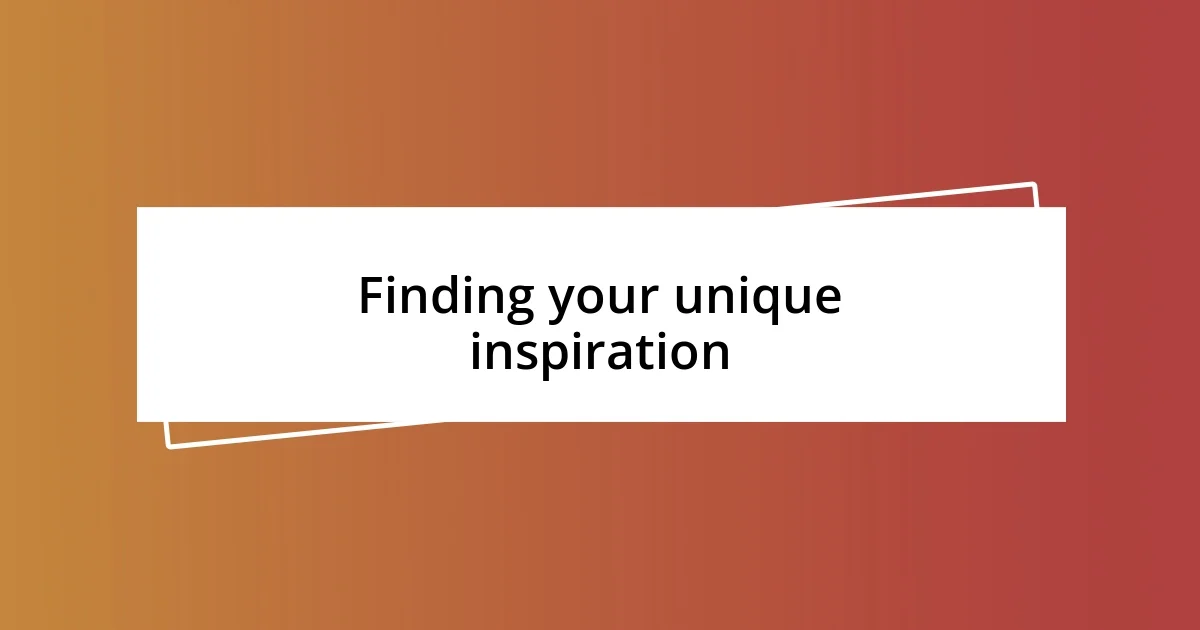
Finding your unique inspiration
Finding your unique source of inspiration can sometimes feel like searching for a rare gem. I recall a moment during a local art fair when I noticed an abstract artist drawing inspiration from everyday objects—things that most of us overlook. It dawned on me: my inspiration doesn’t have to come from the grand and impressive; it can arise from the simplicity of life around me. Have you ever felt that spark when witnessing someone’s unique perspective?
As I navigate through various competitive environments, I keep a journal to jot down those fleeting bursts of inspiration. One entry stands out vividly; I was participating in a writing workshop where everyone shared different styles. A fellow writer’s ability to weave humor into poignant themes opened my eyes to how I could infuse humor into my own storytelling. It made me wonder, where else could I find those unexpected connections in my work? This practice has not only deepened my understanding of my craft but has also become a source of continual motivation.
When exploring these avenues, I ask myself: what truly resonates with me? It’s essential to dig deep into what evokes an emotional response. I experienced this during a photography exhibition when a photo of a solitary tree amidst a busy city struck a chord with me. It reminded me that inspiration can stem from contrast. This realization drives me to seek out my unique inspiration by reflecting on emotions and themes that connect with my authentic self. Have you identified what resonates with you on that level?
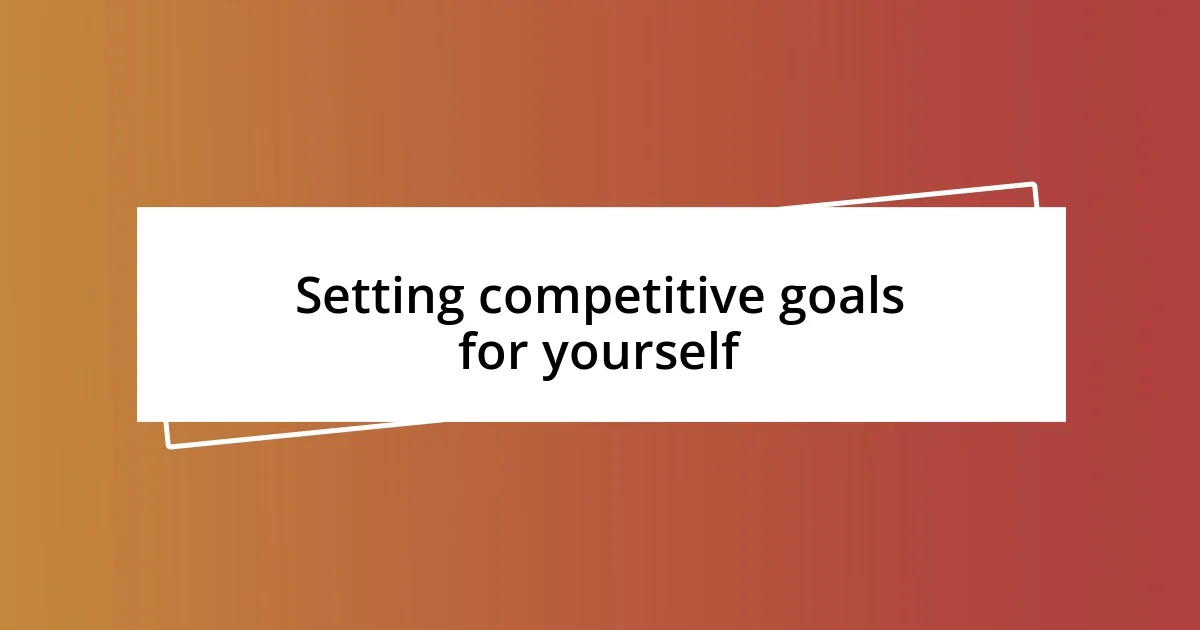
Setting competitive goals for yourself
Setting competitive goals is all about challenging myself to rise above where I currently stand. I remember a time when I set a specific target to win a local photography contest. Instead of just aiming to submit my best piece, I decided to create a series of themed photographs that told a cohesive story. This shift in mindset motivated me to push my creative boundaries and explore new techniques, which ultimately resulted in an unexpected victory.
While creating competitive goals, I find it crucial to break them down into smaller, manageable tasks. For instance, after deciding to enhance my skills in portrait photography, I set weekly goals to practice different styles and techniques. By documenting my progress, I not only tracked my improvements but also felt a sense of accomplishment with each small achievement. Isn’t it fulfilling to see how tiny steps can accumulate into significant growth?
I also believe it’s important to infuse a little flexibility into my goals. There was a time when I rigidly followed a plan to improve my social media presence, only to realize I was missing out on what genuinely inspired me—sharing authentic experiences rather than just curated posts. This realization encouraged me to adjust my goals, focusing on quality connections over numbers. How about you? Have you ever adjusted your goals to reflect what truly drives your passion?
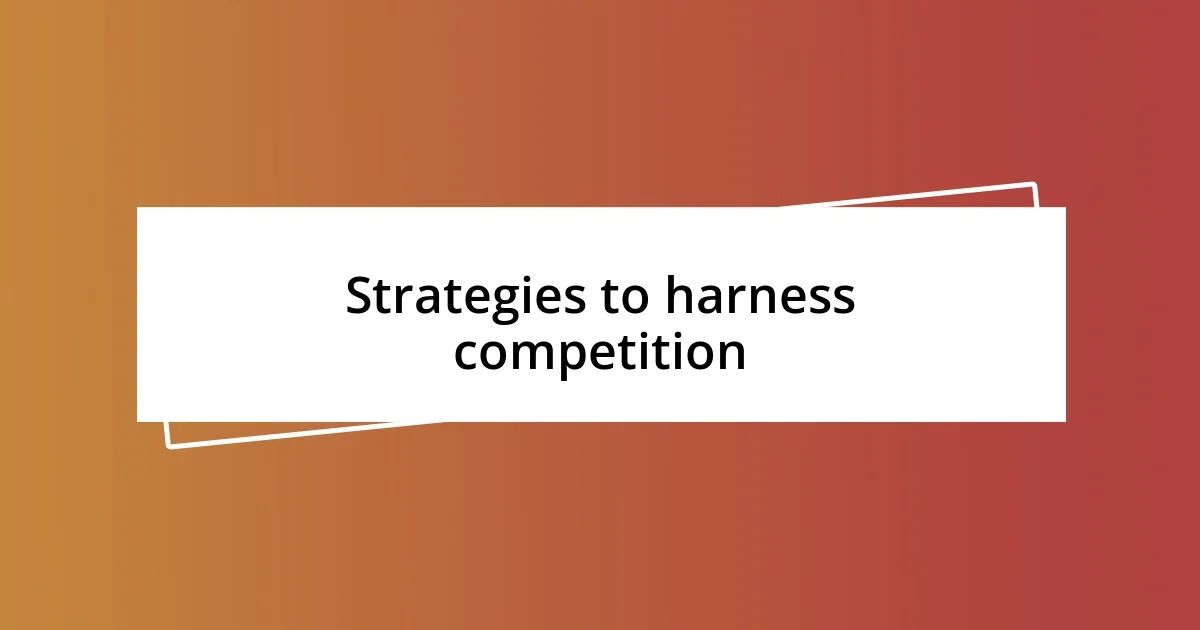
Strategies to harness competition
One effective strategy to harness competition is to engage in collaborative projects with others in your field. I recall teaming up with a couple of local photographers for a joint exhibition. Initially, I thought my competitive spirit would clash with their styles, but instead, I was invigorated by their fresh perspectives. Can you imagine how merging different creative energies can elevate your own work?
Another approach is to maintain a competitive mindset that focuses on personal benchmarks rather than comparison with others. I once felt overwhelmed watching a peer effortlessly gain followers on social media while I struggled. It hit me that I should concentrate on my own growth, setting individualized metrics like quality of content and engagement. This shift not only reduced my anxiety but opened doors for meaningful connections. Do you find value in establishing your own milestones?
Lastly, I find immense inspiration in healthy challenges, which can transform competition into a fun and motivating experience. In one creative writing group, we introduced weekly themes and word limits. The pressure pushed me to think outside the box and ultimately uncovered new strengths in my writing I hadn’t recognized before. How could a little friendly competition ignite your creativity?

Applying competition insights to growth
When I analyze my competitors, I often find unexpected lessons that can fuel my growth. For example, after noticing a fellow photographer utilized unique lighting in her portraits, I felt an urge to experiment with my own lighting techniques. This exploration not only improved my skills but also breathed new life into my portfolio. Isn’t it amazing how a single idea can spark such profound change?
I also embrace the value of feedback from my peers, especially those who may seem like rivals. Once, during a critique session, another photographer pointed out a few areas where I could enhance my image composition. Initially, I felt defensive, but then I realized these insights could guide my next projects. Have you ever changed your perspective can turn seemingly negative feedback into constructive growth?
Additionally, I strive to maintain an adaptable mindset when applying competitive insights. I remember when a new trend in photography emerged, a style I hadn’t previously explored. Instead of shunning it out of fear of not measuring up, I dove in, allowing the competition to push me beyond my comfort zone. The result? A new area of expertise I never knew I could conquer. How do you approach stepping into unfamiliar territory in your journey?












